Study on S-N Curve and Fatigue Limit of Drill Pipe in Offshore Short-Radius Sidetracking Process
Abstract
:1. Introduction
2. Materials and Properties
2.1. Chemical Components
2.2. Microstructure Test
2.3. Tensile Property Test
3. Fatigue Test and S-N Curve Model
3.1. Fatigue Specimen
3.2. Fatigue Test Condition
3.3. S-N Curve Model
3.4. S-N Model Optimization
- (1)
- The Wohler model has the best fitting degree for the fatigue data of the G105 drill pipe material, and its R square is 0.94. This model indicates that there is a linear relationship between S and lg N. However, the Wohler model cannot describe the fact that there is a horizontal progressive line in the S-N curve, and mainly describes the relationship between fatigue life and stress within a certain range. The variation trend of fatigue life with stress cannot be directly reflected.
- (2)
- After fitting, the R-square value of the Basquin model is 0.90, and its fitting method is simple, with a good effect. This model indicates that there is a linear relationship between lg S and lg N, making it the most commonly used S-N curve model in various literature studies. However, similar to the Wohler model, the Basquin model cannot account for the presence of a horizontal asymptotic line in the S-N curve.
- (3)
- The fitting effect of the Zheng model is generally good, with an R-squared value of 0.77. The Zheng model is actually a special form of the Stromeyer model. It can represent the presence of a fatigue limit and indicates the existence of a horizontal asymptote in the S-N curve. This means that as the test stress Sa approaches the fatigue limit Sac infinitely, the fatigue life N tends to infinity. However, the application of this model is limited, and it does not fit well with the drill pipe fatigue test data.
- (4)
- The Stromeyer model has a fitted R-square of 0.88, indicating a good fit. This model effectively depicts the relationship between fatigue life and stress level, showing the trend of fatigue life as stress changes. Overall, the model’s effectiveness is satisfactory.
4. Results and Discussion
4.1. Results
4.1.1. In Air
4.1.2. In High-Temperature Conditions
4.1.3. In Drilling Fluid
4.1.4. In H2S Drilling Fluid
4.2. Fatigue Factor Sensitivity Analysis
4.3. Fatigue Failure Mechanism
5. Conclusions
- (1)
- The results of the evaluation of the S-N curve model indicate that the Wohler, Basquin, and Stromeyer models can effectively describe the fatigue test results of the drill pipe. The fitting correlation coefficients for all three models are above 0.86. The prediction error of the Stromeyer model is less than 5.62%, which is the closest to the measured value. This model provides a more accurate and intuitive description of the fatigue behavior of drill pipe materials.
- (2)
- The fatigue test results indicate that the mechanical fatigue life of a drill pipe in a non-corrosive environment is primarily influenced by the steel grade. However, in a corrosive environment with the same stress level, the corrosion fatigue life of a titanium alloy drill pipe outperforms that of a steel drill pipe. Furthermore, when corrosion and fatigue happen simultaneously, the combined effect on drill pipe life is significantly greater than that of either factor acting alone.
- (3)
- During short-radius sidetracking, the sensitivity sequence of different types of drill pipe to environmental media is as follows: for temperature: Ti110 (4.65%) > G105 (4.21%) > V150 (3%) > S135 (1.58%); for drilling fluid, S135 (34.2%) > V150 (33.04%) > G105 (19.76%) > Ti110 (4.55%). for H2S—drilling fluid: V150 (40.13%) > S135 (37.51%) > G105 (29.62%) > Ti110 (15.04%).
- (4)
- During the process of corrosion fatigue, the protective film on the surface of a titanium alloy drill pipe helps to safeguard the internal structure and prevent corrosion. In contrast, the protective film on a steel drill pipe is more prone to damage, leading to internal corrosion of the structure and exacerbating the formation and spread of micro-cracks. This is the primary factor contributing to the difference in fatigue life between titanium and steel drill pipes.
Supplementary Materials
Author Contributions
Funding
Data Availability Statement
Acknowledgments
Conflicts of Interest
References
- Peng, X.; Yu, H.; Lian, Z.; Zhang, Q. Experimental and theoretical study on the mechanical properties of titanium alloy drill pipe in short radius and long horizontal wells. J. Braz. Soc. Mech. Sci. Eng. 2021, 43, 416. [Google Scholar] [CrossRef]
- Zhong, H. Research and application of drilling and completion technology of ultra-short radius sidetracking horizontal well. West. Explor. Eng. 2023, 35, 37–40. [Google Scholar]
- Chen, X.; Zhang, Q.; Li, Y.; Liu, J.; Liu, Z.; Liu, S. Investigation on enhanced oil recovery and CO2 storage efficiency of temperature-resistant CO2 foam flooding. Fuel 2024, 364, 130870. [Google Scholar] [CrossRef]
- Peng, X.; Yu, H.; Lian, Z.; Dong, B.; Zhong, W.; Zhang, Y.; Hu, Z. Material optimization of drill pipe in complex wellbore environments by comparing fatigue life and cost. Energy Rep. 2021, 7, 5420–5430. [Google Scholar] [CrossRef]
- Speller, F.N. Corrosion fatigue of drill pipe. In Proceedings of the Sixteenth Annual Meeting of API, Los Angeles, CA, USA, 1935; p. 239. [Google Scholar]
- Morgan, R.P.; Roblin, M.J. A method for the investigation of fatigue strength in seamless drillpipe. In Proceedings of the 1969 ASME Conference, Tulsa, OK, USA, 21–23 August 1969; Volume 227. [Google Scholar]
- Zamani, S.M.; Hassanzadeh-Tabrizi, S.A.; Sharifi, H. Failure analysis of drill pipe: A review. Eng. Fail. Anal. 2016, 59, 605–623. [Google Scholar] [CrossRef]
- Luo, S.; Liu, M.; Zheng, X. Characteristics and life expression of fatigue fracture of G105 and S135 drill pipe steels for API grade. Eng. Fail. Anal. 2020, 116, 104705. [Google Scholar] [CrossRef]
- Zou, H.; Tan, Z. Fatigue life analysis of rotary drill pipe. Int. J. Press. Vessel. Pip. 2023, 201, 104874. [Google Scholar] [CrossRef]
- Yu, H.; Peng, X.; Lian, Z.; Shi, T.; Wang, J.; Zhao, Z. Experimental and numerical simulation of fatigue corrosion behavior of V150 high-strength drill pipe in air and H2S-dilling mud environment. J. Nat. Gas Sci. Eng. 2022, 98, 104392. [Google Scholar] [CrossRef]
- Peng, X.; Yu, H.; Lian, Z.; Liu, T.; Shi, J.; Yang, D. Study on Fatigue Behavior of S135 Steel and Titanium Alloy Drillpipes: Experiment and Modeling. SPE Drill. Complet. 2023, 38, 261–272. [Google Scholar] [CrossRef]
- Zeng, D.; Li, H.; Tian, G.; Liu, F.; Li, B.; Yu, S.; Shi, T. Fatigue behavior of high-strength steel S135 under coupling multi-factor in complex environments. Mater. Sci. Eng. A 2018, 724, 385–402. [Google Scholar] [CrossRef]
- Qi, H.Y.; Zheng, X.L.; Ma, L.Q.; Li, S.L.; Yang, X.G.; Shi, D.Q. Low-cycle fatigue behavior of DZ125 superalloy under prior exposure conditions. Rare Met. 2023, 42, 2028–2036. [Google Scholar] [CrossRef]
- Wu, Z.Y.; Liu, Y.J.; Wu, X.; Liu, X.C.; Wang, J.C.; Wang, Q. Fatigue performance of beta titanium alloy topological porous structures fabricated by laser powder bed fusion. J. Mater. Res. Technol. 2024, 29, 4772–4780. [Google Scholar] [CrossRef]
- Lu, W.Q.; Liu, Y.J.; Wu, X.; Liu, X.C.; Wang, J.C. Corrosion and passivation behavior of Ti-6Al-4V surfaces treated with high-energy pulsed laser: A comparative study of cast and 3D-printed specimens in a NaCl solution. Surf. Coat. Technol. 2023, 470, 129849. [Google Scholar] [CrossRef]
- Lu, J.; Ge, P.; Zhao, Y. Recent development of effect mechanism of alloying elements in titanium alloy design. Rare Met. Mater. Eng. 2014, 43, 775–779. [Google Scholar] [CrossRef]
- Kolli, R.P.; Devaraj, A. A review of metastable beta titanium alloys. Metals 2018, 8, 506. [Google Scholar] [CrossRef]
- GB/T 228.1-2010; Metal Materials—Tensile Test—Part 1: Room Temperature Test Method. Standards Press of China: Beijing, China, 2010.
- GB/T 4337-2015; Rotating Bending Method for Fatigue Test of Metal Materials. Standards Press of China: Beijing, China, 2015.
- Burhan, I.; Kim, H.S. SN curve models for composite materials characterisation: An evaluative review. J. Compos. Sci. 2018, 2, 38. [Google Scholar] [CrossRef]
- Wöhler, A. Über die Festigkeitsversuche mit Eisen und Stahl; Ernst & Korn: Berlin, Germany, 1870. [Google Scholar]
- Basquin, O.H. The exponential law of endurance tests. Proc. Am. Soc Test Mater. 1910, 10, 625–630. [Google Scholar]
- Aeran, A.; Siriwardane, S.C.; Mikkelsen, O.; Langen, I. A new nonlinear fatigue damage model based only on SN curve parameters. Int. J. Fatigue 2017, 103, 327–341. [Google Scholar] [CrossRef]
- Zheng, X.; Wang, H.; Yan, J. Material Fatigue Theory and Engineering Application; Science Press: Beijing, China, 2013. [Google Scholar]
- Chen, L.; Liu, W.; Zhang, T.; Dong, B.; Li, H.; Sun, Y.; Li, W. Interaction of silty sand and preformed corrosion products on N80 carbon steel in CO2 environment. Corros. Sci. 2022, 205, 110467. [Google Scholar] [CrossRef]
- Wang, Y.; Wang, B.; He, S.; Zhang, L.; Xing, X.; Li, H.; Lu, M. Unraveling the effect of H2S on the corrosion behavior of high strength sulfur-resistant steel in CO2/H2S/Cl− environments at ultra high temperature and high pressure. J. Nat. Gas Sci. Eng. 2022, 100, 104477. [Google Scholar] [CrossRef]
- Wei, L.; Pang, X.; Gao, K. Corrosion of low alloy steel and stainless steel in supercritical CO2/H2O/H2S systems. Corros. Sci. 2016, 111, 637–648. [Google Scholar] [CrossRef]
- Zhang, L.C.; Chen, L.Y.; Wang, L. Surface modification of titanium and titanium alloys: Technologies, developments, and future interests. Adv. Eng. Mater. 2020, 22, 1901258. [Google Scholar] [CrossRef]
- Sartale, S.D.; Ansari, A.A.; Rezvani, S.J. Influence of Ti film thickness and oxidation temperature on TiO2 thin film formation via thermal oxidation of sputtered Ti film. Mater. Sci. Semicond. Process. 2013, 16, 2005–2012. [Google Scholar] [CrossRef]
- Tao, Q.; Ding, W.; Chen, G.; Qu, X.; Qin, M. Towards an atomic-scale understanding of oxide film in the Ti powder surface. Scr. Mater. 2022, 210, 114471. [Google Scholar] [CrossRef]
- Bodunrin, M.O.; Chown, L.H.; Van Der Merwe, J.W.; Alaneme, K.K.; Oganbule, C.; Klenam, D.E.; Mphasha, N.P. Corrosion behavior of titanium alloys in acidic and saline media: Role of alloy design, passivation integrity, and electrolyte modification. Corros. Rev. 2020, 38, 25–47. [Google Scholar] [CrossRef]
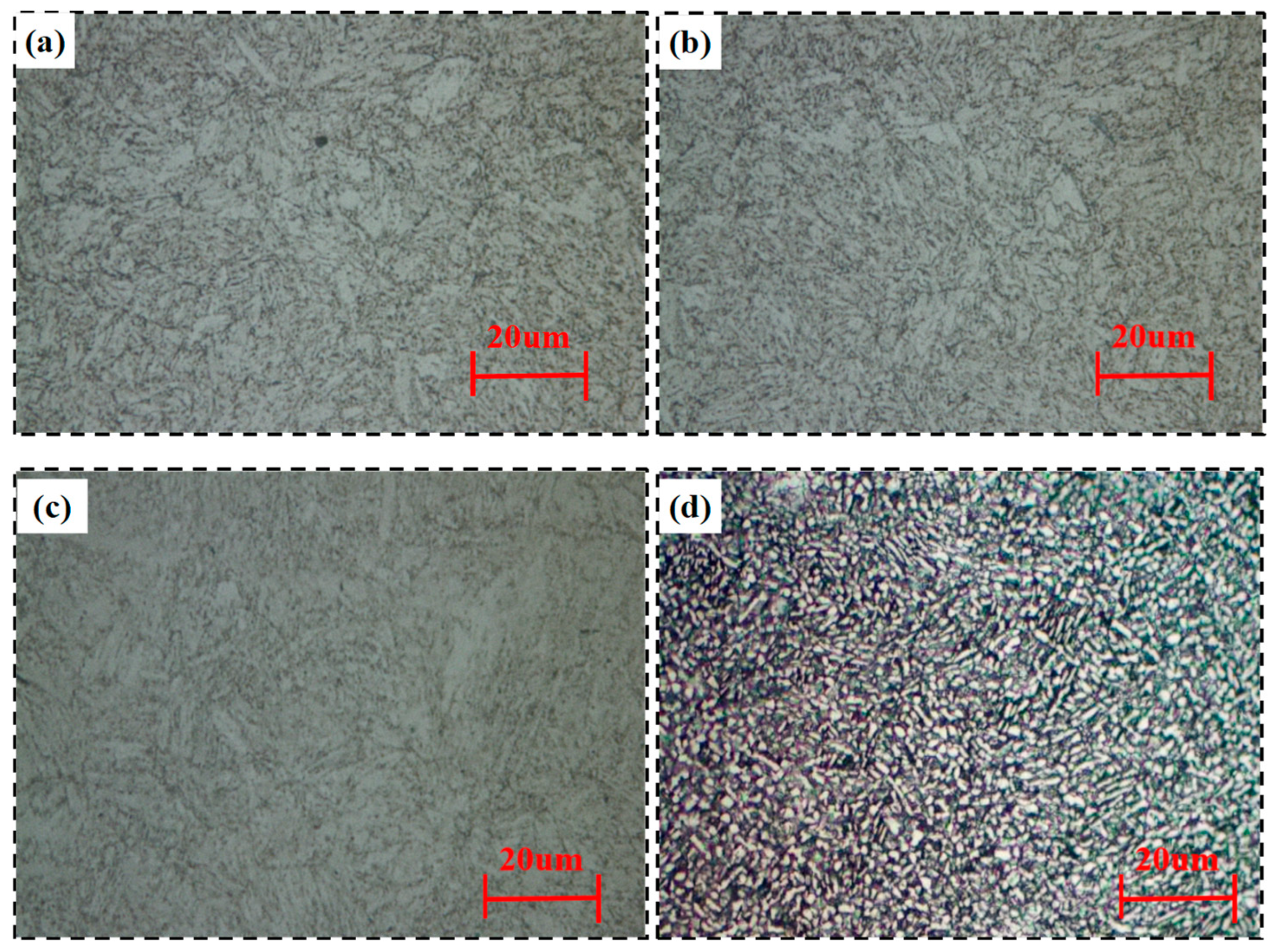
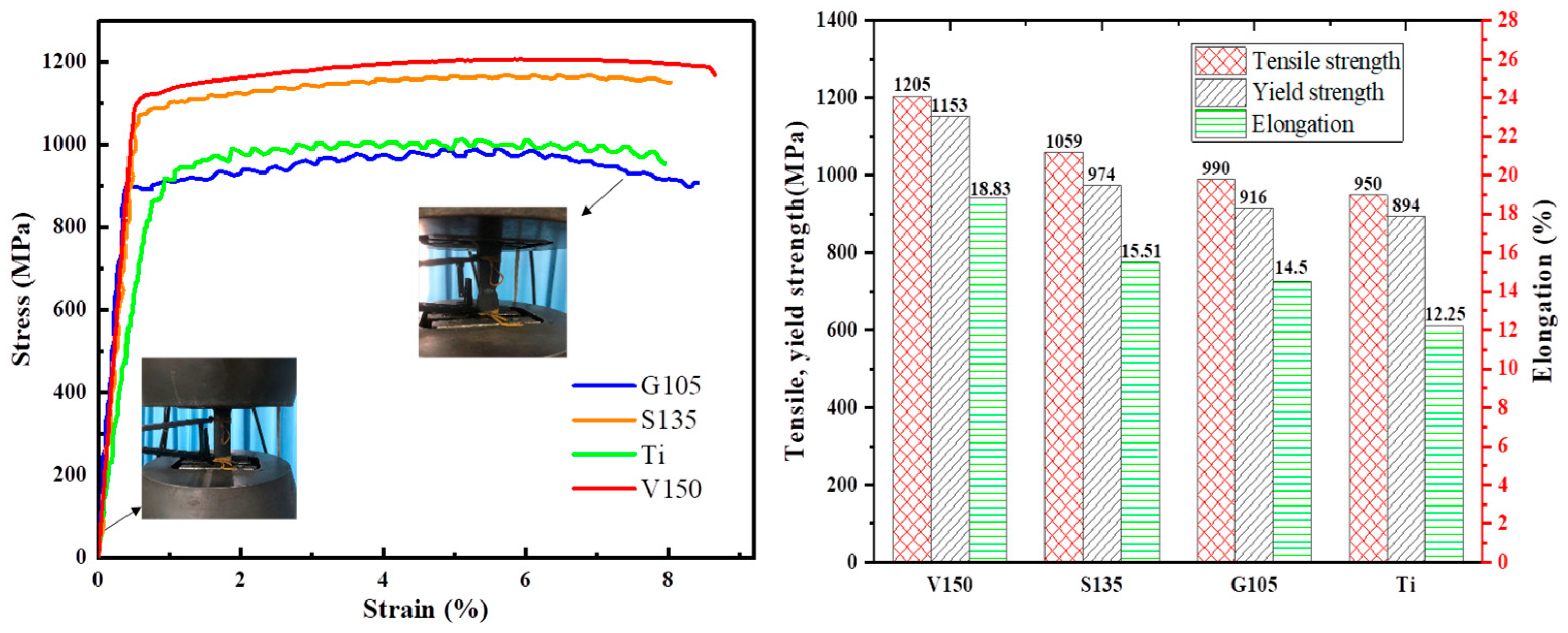

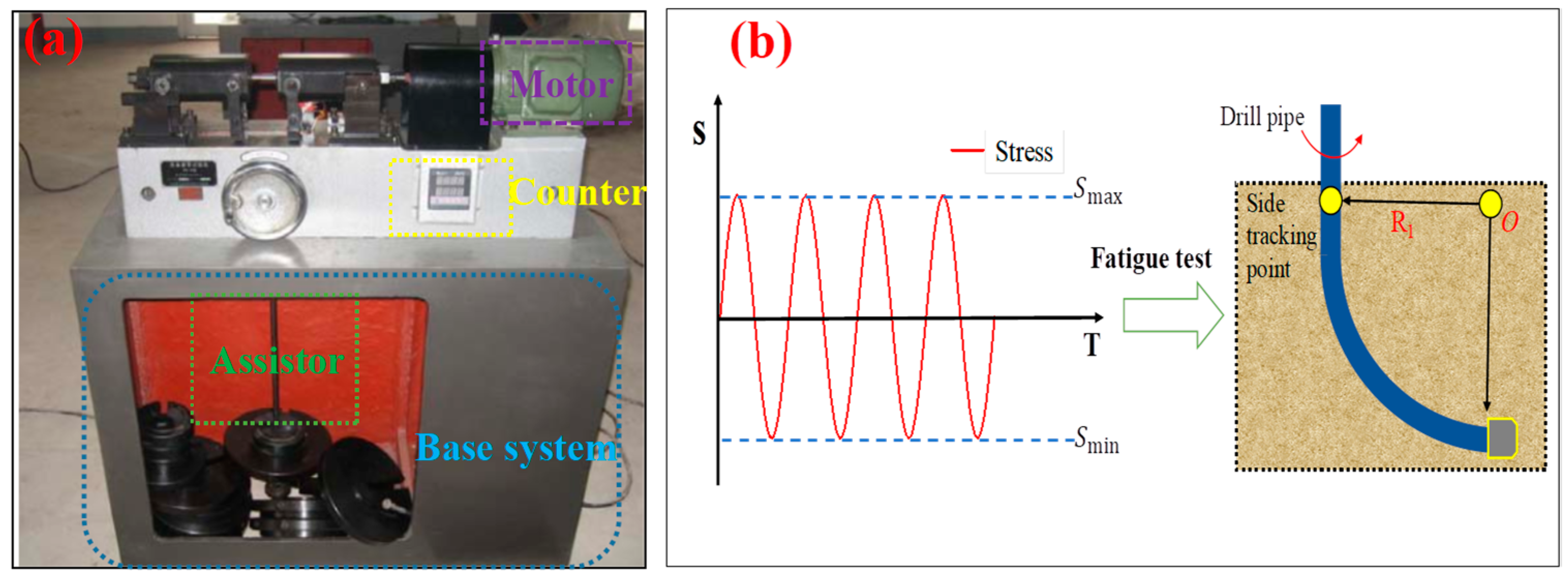
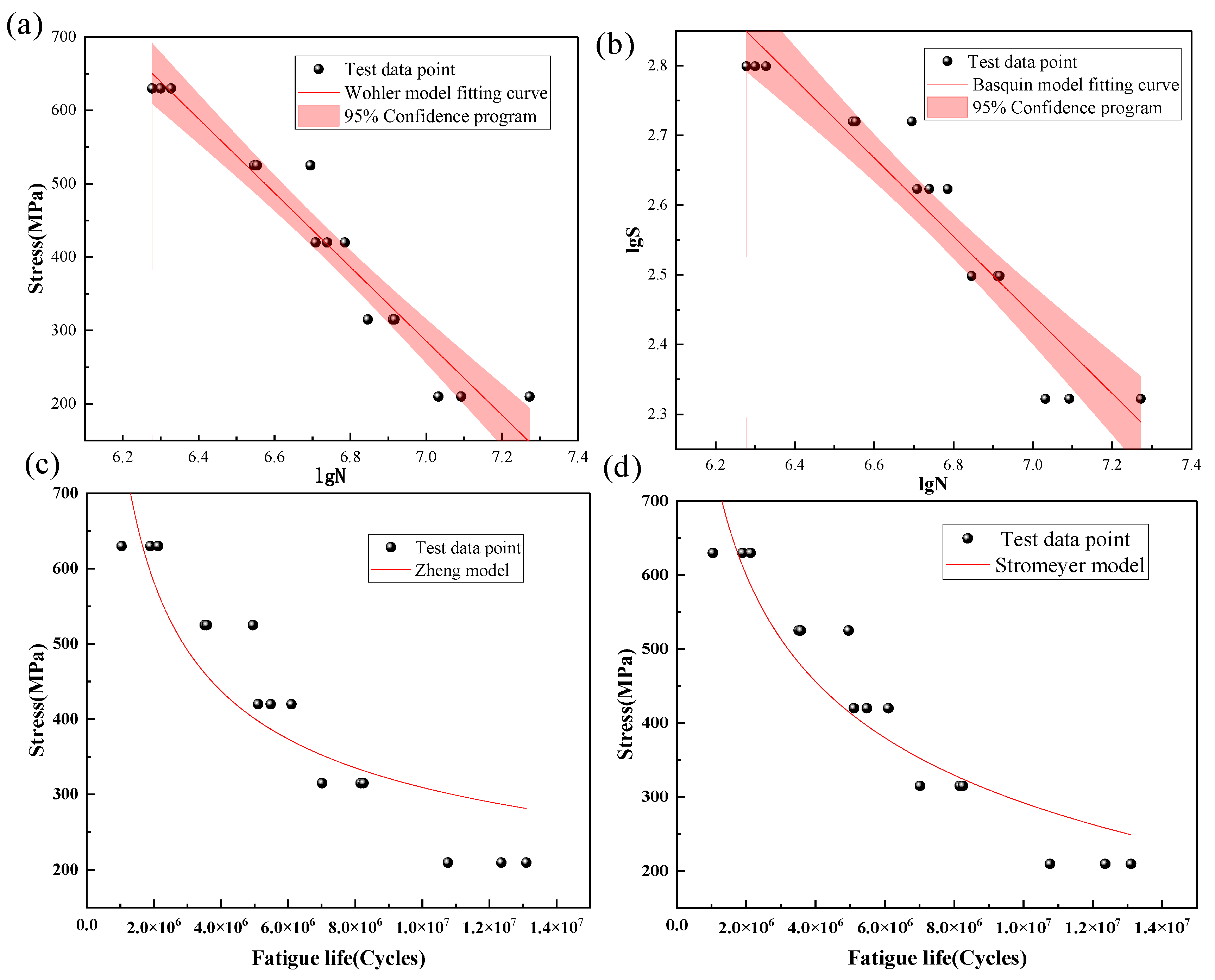
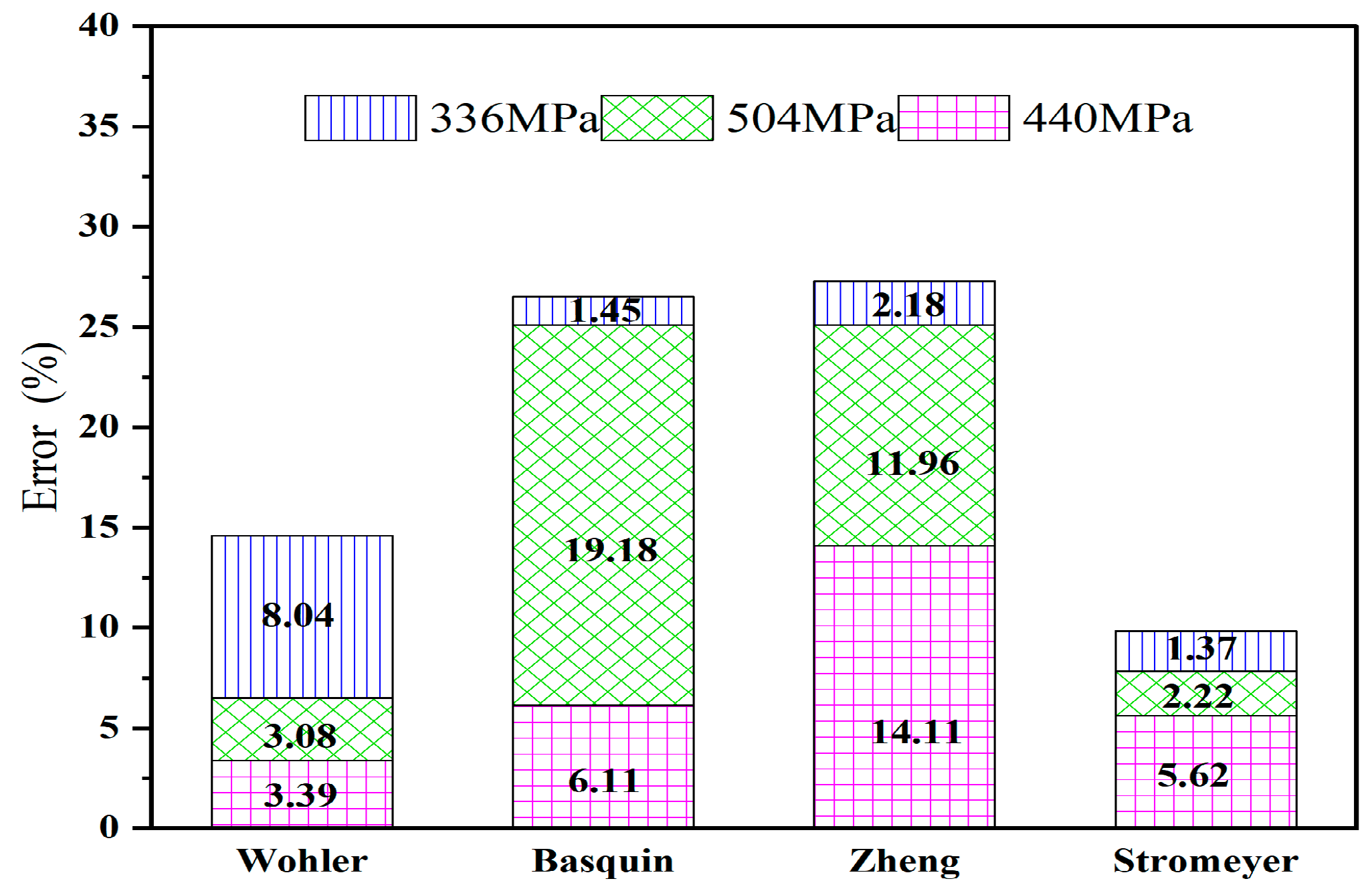
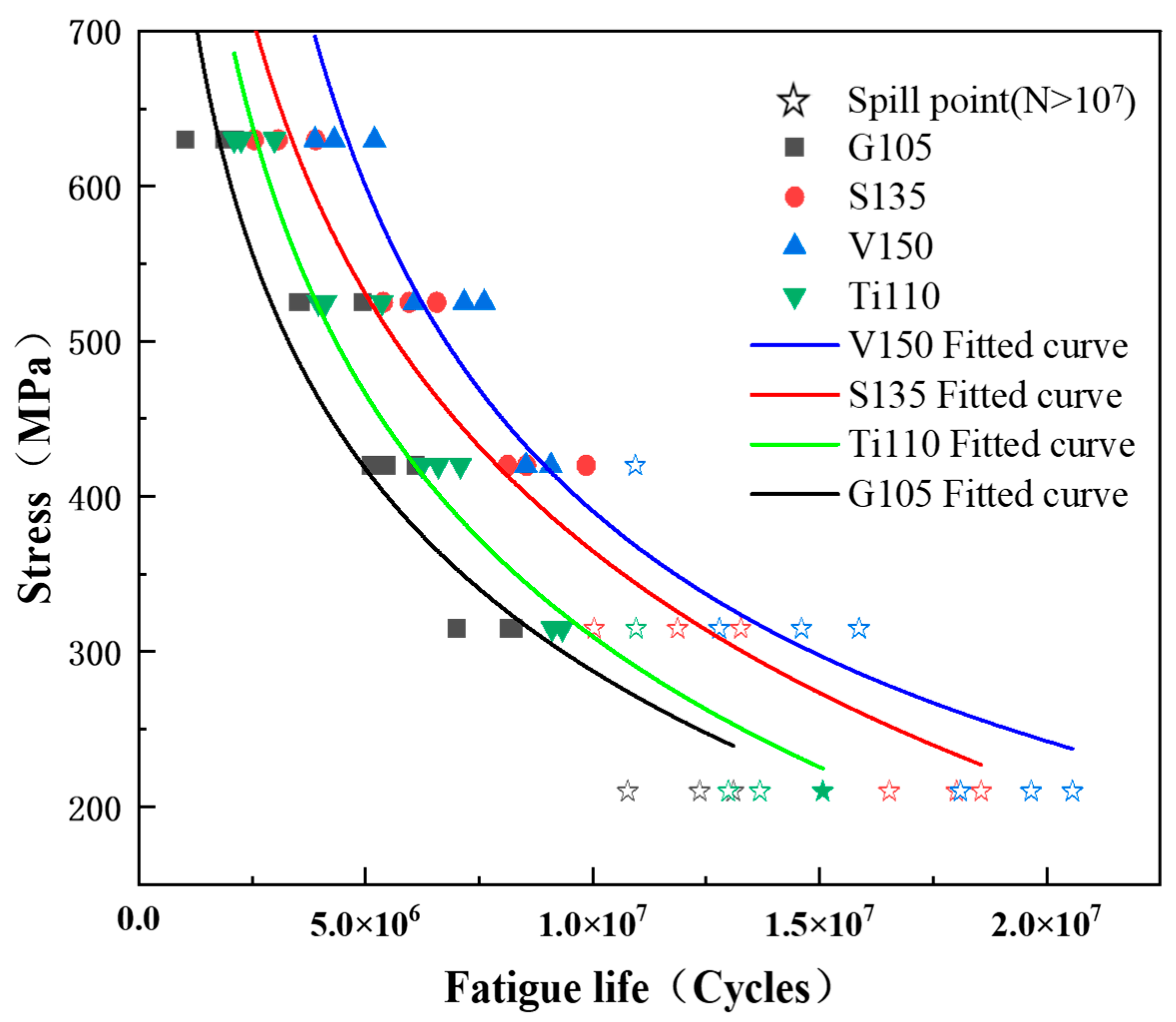

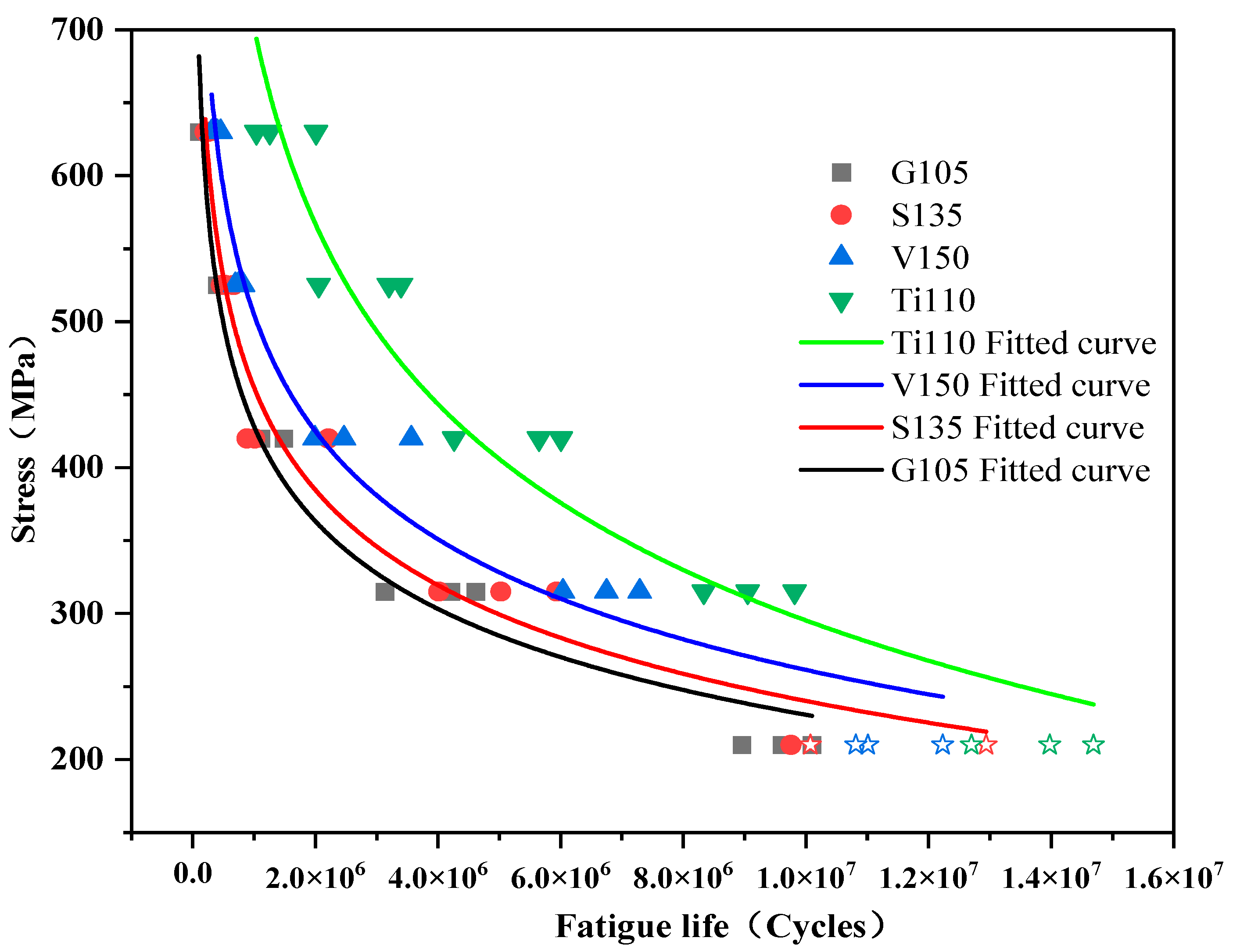


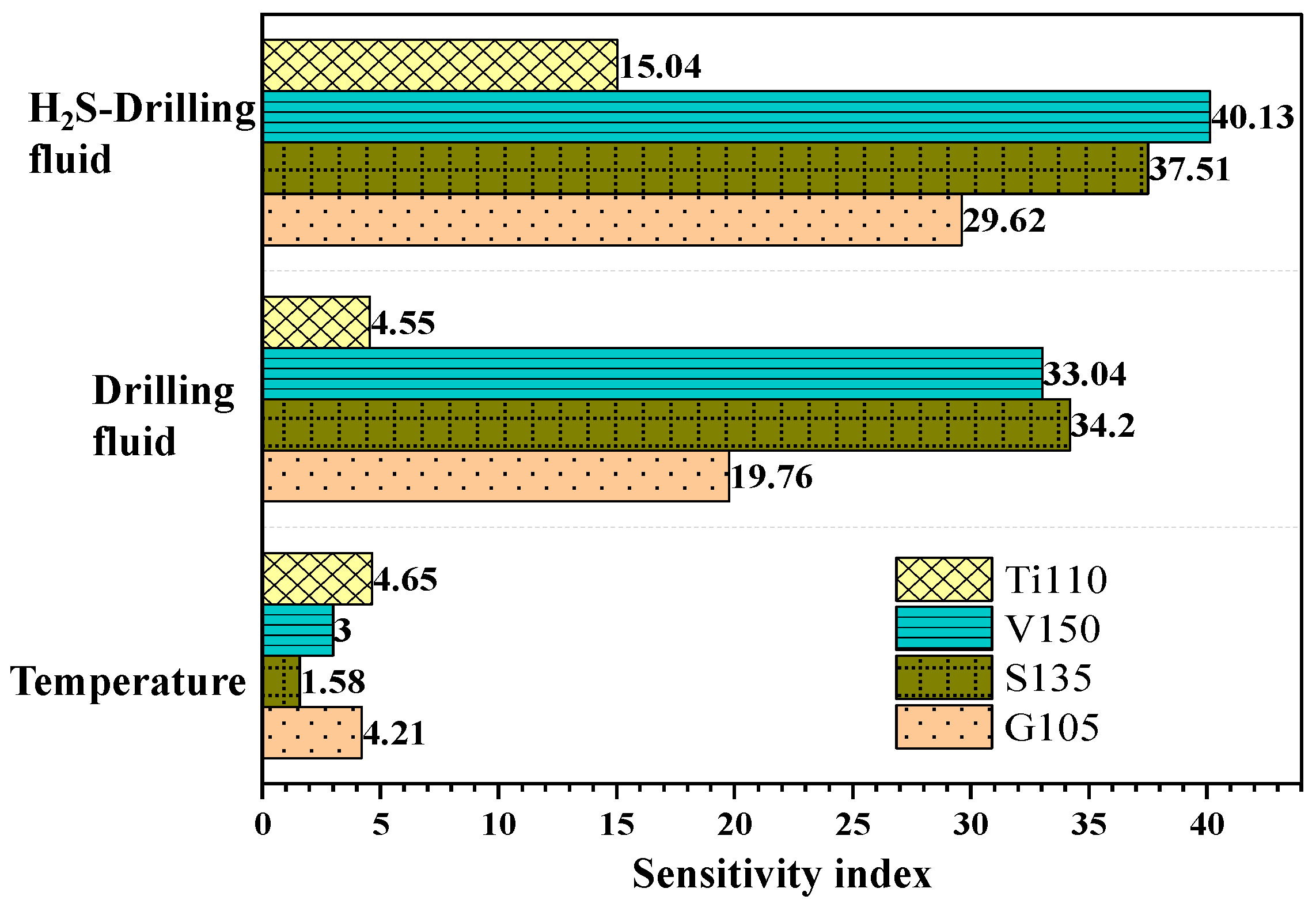
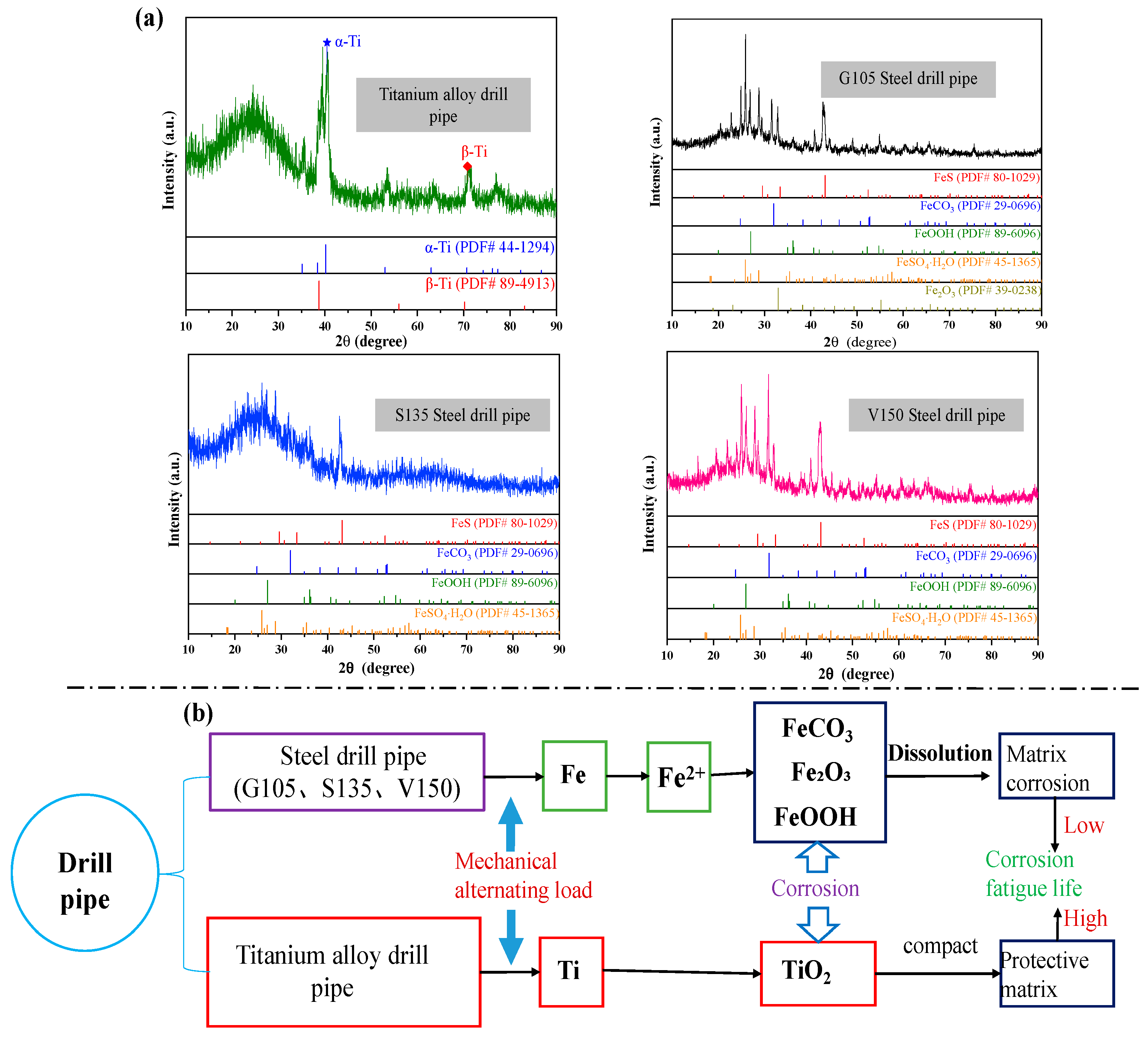
| Drill Pipe | C | Si | Mn | P | AI | Mo | Ni | Cr | Fe | Ti |
|---|---|---|---|---|---|---|---|---|---|---|
| G105 | 0.37 | 0.27 | 0.13 | 0.02 | 0.019 | 0.13 | 0.11 | 0.08 | Balance | 0.01 |
| S135 | 0.37 | 0.24 | 0.96 | 0.011 | 0.023 | 0.32 | 0.08 | 1.14 | Balance | 0.01 |
| V150 | 0.25 | 0.30 | 0.58 | 0.009 | 0.03 | 0.87 | 0.69 | 1.09 | Balance | 0.02 |
| Ti | 0.015 | 0.05 | / | / | 5.44 | 2.80 | / | 1.29 | 0.02 | Balance |
| API Spec5D | / | / | / | <0.03 | / | / | / | / | / | / |
| Drill Pipe Material | Stress Level | Test Environment | Remark |
|---|---|---|---|
| G105 S135 V150 Ti | 210 MPa 315 MPa 420 MPa 525 MPa 630 MPa | Room temperature in air | Each drill pipe sample should be subjected to 5 groups of fatigue tests at different stress levels under different test environments. |
| High temperature | |||
| Drilling fluid | |||
| H2S drilling fluid |
| Model | Fitting Formula | R-Squared | Fatigue Limit (MPa) |
|---|---|---|---|
| Wohler | 0.94 | 263.47 | |
| Basquin | 0.90 | 294.44 | |
| Zheng | 0.77 | 309.30 | |
| Stromeyer | 0.88 | 287.86 |
Disclaimer/Publisher’s Note: The statements, opinions and data contained in all publications are solely those of the individual author(s) and contributor(s) and not of MDPI and/or the editor(s). MDPI and/or the editor(s) disclaim responsibility for any injury to people or property resulting from any ideas, methods, instructions or products referred to in the content. |
© 2024 by the authors. Licensee MDPI, Basel, Switzerland. This article is an open access article distributed under the terms and conditions of the Creative Commons Attribution (CC BY) license (https://creativecommons.org/licenses/by/4.0/).
Share and Cite
Sun, Y.; Peng, X.; Bi, G. Study on S-N Curve and Fatigue Limit of Drill Pipe in Offshore Short-Radius Sidetracking Process. Processes 2024, 12, 1828. https://doi.org/10.3390/pr12091828
Sun Y, Peng X, Bi G. Study on S-N Curve and Fatigue Limit of Drill Pipe in Offshore Short-Radius Sidetracking Process. Processes. 2024; 12(9):1828. https://doi.org/10.3390/pr12091828
Chicago/Turabian StyleSun, Yufei, Xianbo Peng, and Gang Bi. 2024. "Study on S-N Curve and Fatigue Limit of Drill Pipe in Offshore Short-Radius Sidetracking Process" Processes 12, no. 9: 1828. https://doi.org/10.3390/pr12091828





